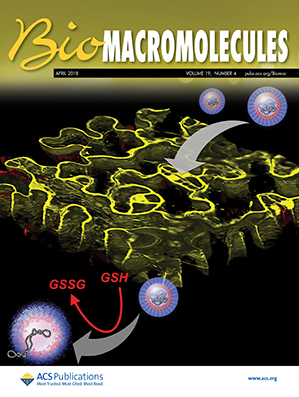The Hidden Isodimorphic Crystallization of Poly(ε-Caprolactone-Ran-ω-Pentadecalactone) Copolymers
IF 5.5
2区 化学
Q1 BIOCHEMISTRY & MOLECULAR BIOLOGY
引用次数: 0
Abstract
Poly(ε-caprolactone-ran-ω-pentadecalactone) (PCL x -PPDL y ) copolymers were synthesized by using ring-opening polymerization with Candida antarctica lipase B as a catalyst across various compositions. The aim was to study their crystallization behavior and ascertain whether they are isomorphic or isodimorphic. Differential scanning calorimetry, polarized light optical microscopy, in situ wide- and small-angle X-ray scattering, and Fourier-transform infrared spectroscopy were employed to assess the crystallization mode. Various crystallization conditions were used to investigate their influence on the comonomer inclusion/exclusion balance. The copolymers exhibited pseudoeutectic behavior across all compositions, crystallizing in either PPDL-type or PCL-type unit cells and conformations, independent of crystallization conditions. This indicates that they are isodimorphic, contrary to previous reports. Self-nucleation tests showed that the Domain II width decreases with increasing comonomer content, supporting isodimorphism. The pseudoeutectic point was observed at CL contents above 83%, which explains the previously unrecognized isodimorphic character of these copolyesters.
- Download: Download high-res image (75KB)
- Download: Download full-size image
聚(ε-己内酯- ran -ω-五内酯)共聚物的隐性同二晶化。
以南极念珠菌脂肪酶B为催化剂,采用开环聚合法制备了聚(ε-己内酯-ran-ω-五内酯)共聚物(PCLx-PPDLy)。目的是研究它们的结晶行为,确定它们是同形的还是同二形的。采用差示扫描量热法、偏振光光学显微镜、原位广角和小角x射线散射以及傅里叶变换红外光谱对结晶模式进行了评价。采用不同的结晶条件考察了它们对共单体包合/排斥平衡的影响。共聚物在所有组成中都表现出假共晶行为,在不同的结晶条件下,都可以以ppdl型或pcl型的晶胞和构象结晶。这表明它们是同二态的,与以前的报道相反。自核试验表明,结构域宽度随共聚单体含量的增加而减小,支持等二态性。在CL含量高于83%时观察到假共晶点,这解释了这些共聚酯以前未被认识到的同二晶特征。
本文章由计算机程序翻译,如有差异,请以英文原文为准。
求助全文
约1分钟内获得全文
求助全文
来源期刊

Biomacromolecules
化学-高分子科学
CiteScore
10.60
自引率
4.80%
发文量
417
审稿时长
1.6 months
期刊介绍:
Biomacromolecules is a leading forum for the dissemination of cutting-edge research at the interface of polymer science and biology. Submissions to Biomacromolecules should contain strong elements of innovation in terms of macromolecular design, synthesis and characterization, or in the application of polymer materials to biology and medicine.
Topics covered by Biomacromolecules include, but are not exclusively limited to: sustainable polymers, polymers based on natural and renewable resources, degradable polymers, polymer conjugates, polymeric drugs, polymers in biocatalysis, biomacromolecular assembly, biomimetic polymers, polymer-biomineral hybrids, biomimetic-polymer processing, polymer recycling, bioactive polymer surfaces, original polymer design for biomedical applications such as immunotherapy, drug delivery, gene delivery, antimicrobial applications, diagnostic imaging and biosensing, polymers in tissue engineering and regenerative medicine, polymeric scaffolds and hydrogels for cell culture and delivery.
 求助内容:
求助内容: 应助结果提醒方式:
应助结果提醒方式:


